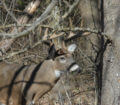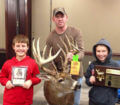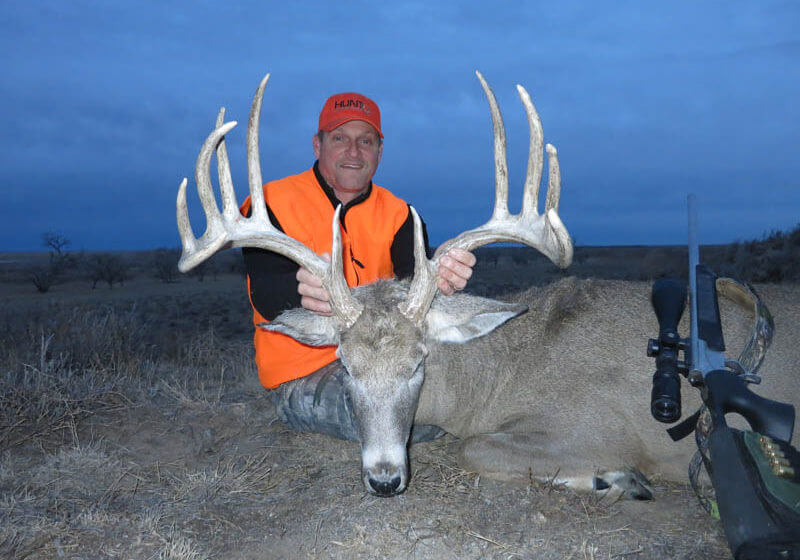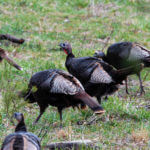John’s Note: Finding and taking a big deer is a process of connecting the dots with the knowledge you’ve learned from people who consistently take big bucks. Sure, some of the hunters who bag big deer just got lucky. But others have put together tactics that regularly produce trophy bucks. See if you can connect the dots this week of these featured deer hunters.
“Have you ever crawled like this with live ammunition passing over your head?” Bill Lambert of West Monroe, Louisiana, asked his guide Ty McFarland on December 4, 2014. Lambert had crawled on his belly for over a 1/2-mile, hoping to get into position to take shot at a monster whitetail. Lambert had hunted whitetails for more than 38 years and also served in the military. He realized he had to employ his military training to get in close to this whitetail he was hunting in Kiowa County, Colorado. Lambert had applied for a mule deer hunt but didn’t get drawn. However, he did draw a preferred whitetail tag. Lambert and a group of his friends didn’t have any clues about where or how to hunt the big whitetails in Kiowa County. So, the group contacted Global Hunting Resources (http://www.globalhuntingresources.com), an outfitter they’d met at the Dallas Safari Club Convention.
 Each guide took two hunters every day. “On this hunt, my partner was Scott Tubbs from Bastrop, La.,” Lambert says. “We drew straws to see who would get the first shot, and Scott won.” The hunt started on Monday. The two men saw plenty of big bucks on this hunt right after the rut – but the big bucks all had antlers broken off their racks. However, McFarland already had scouted the area and spotted a big 5×6 with no broken antlers, that probably would score 160 or better.
Each guide took two hunters every day. “On this hunt, my partner was Scott Tubbs from Bastrop, La.,” Lambert says. “We drew straws to see who would get the first shot, and Scott won.” The hunt started on Monday. The two men saw plenty of big bucks on this hunt right after the rut – but the big bucks all had antlers broken off their racks. However, McFarland already had scouted the area and spotted a big 5×6 with no broken antlers, that probably would score 160 or better.
“We knew the buck was feeding in a cornfield,” Lambert explains. “The first morning, we set-up to take the buck coming out of the cornfield and returning to his bed. When the sun appeared, we spotted another buck about 2 miles away. Lambert used 10X binoculars and saw both bucks had good racks, with one buck’s rack noticeably larger. The bucks were headed to private property where our outfitter didn’t have permission to hunt.”
On the second day of the hunt. Tubbs was positioned to take the big 5×6, but once again the buck got past him and out of range. Then the hunters learned that the ranch owner always went out before daylight and broke ice in the water troughs for his cattle, which spooked the bucks out of the cornfield before daylight.
 During the third day of the hunt, Lambert and his party never spotted the 5×6, although they saw plenty of busted rack bucks. On the fourth day of the hunt, the wind changed. The hunters got on top of a high hill. The 5×6 was with three does, and a smaller 5×6 was about 1/2-mile from the stand. Tubbs was set-up perfectly and in position to take the shot as the small band of whitetails moved toward him. Just before the deer got in to range, a cow bedded down by a fencepost moved and spooked the does. They ran off but started moving back toward the cornfield.
During the third day of the hunt, Lambert and his party never spotted the 5×6, although they saw plenty of busted rack bucks. On the fourth day of the hunt, the wind changed. The hunters got on top of a high hill. The 5×6 was with three does, and a smaller 5×6 was about 1/2-mile from the stand. Tubbs was set-up perfectly and in position to take the shot as the small band of whitetails moved toward him. Just before the deer got in to range, a cow bedded down by a fencepost moved and spooked the does. They ran off but started moving back toward the cornfield.
“We left Scott where he easily should have been able to get a shot, and Ty and I pulled out and went to another hill,” Lambert explains. “We spooked a band of 30 pronghorns that took off like someone had lit fires to their behinds, running straight toward the small band of whitetails before finally turning.” Lambert and McFarland heard a shot and thought Tubbs had taken the big buck, but later learned he’d missed the 5×6 four times. McFarland set-up his spotting scope and saw the two bucks with the three does about 2-miles away, walking down a fence line, and realized Tubbs had missed the big buck. The whitetails bedded down on the opposite side of the fence behind piled up tumbleweeds. On the side of the fence closest to Lambert, a mule deer buck was bedded there.
“We need to go after the big whitetail right now,” McFarland said. “We know where he’s at, he’s bedded down, and this probably will be the last chance to take that big buck before he moves off our property onto private lands.” The two men began crossing open country with grass not even knee-high. McFarland went first, and Lambert walked in his shadow. The mule deer buck kept a close eye on the two hunters. Once they were within a mile of the bedded big whitetail, they bent over, walked low to the ground and then laid on their stomachs and low crawled on their bellies for about 1/2-mile, with their chins only about 4 inches off the ground. The mule deer buck stood up and walked down the fence line, and at the same time, the 5×6 stood up. The hunters watched the big whitetail go to the bathroom and then lay back down.
 Once the hunters were 200–250 yards from the bedded whitetail, Lambert took his backpack off and rested his Thompson Center (https://www.tcarms.com) .300 Win Mag on his daypack. After leaving the truck at 9:00 am, the time now was 2:00 pm. The wind shifted and started blowing straight to the bedded whitetails. The big whitetail stood up on the right. McFarland whispered, “Whoa, that’s not the big buck.”
Once the hunters were 200–250 yards from the bedded whitetail, Lambert took his backpack off and rested his Thompson Center (https://www.tcarms.com) .300 Win Mag on his daypack. After leaving the truck at 9:00 am, the time now was 2:00 pm. The wind shifted and started blowing straight to the bedded whitetails. The big whitetail stood up on the right. McFarland whispered, “Whoa, that’s not the big buck.”
When this big 5×6 stood up behind a tumbleweed, the hunters only could see his head and rack.
“I couldn’t see enough of the deer to make the shot,” Lambert remembers.
But McFarland assured him that the .300 Win Mag would punch through the tumbleweed. Once Lambert saw the top of the buck’s back, he lowered his rifle to the spot where he knew the whitetail’s shoulder should be and squeezed the trigger. The buck went down. Lambert and McFarland found the buck up against the fence in the tumbleweeds. Tubbs appeared and explained he’d seen the hunt through his binoculars. McFarland took a good look at the deer and announced, “That’s at least a180-inch buck,” and he was.
* BTR Score – Buckmasters’ Composite Score – Number of Inches: 185-1/8
* Official Buckmasters’ Score: 165-2/8 (doesn’t include inside spread of main beams)
To learn more about hunting deer, see John E. Phillips’ eBooks and print books at www.amazon.com/author/johnephillips and www.barnesandnoble.com. John’s newest deer-hunting book, “Whitetail Deer and the Hunters Who Take Big Bucks” is available at http://amzn.to/2bYwYOK/.










